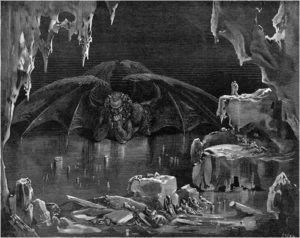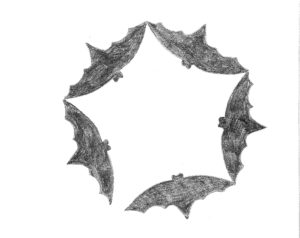East Bats, West Bats
Western culture, brought over here by Europeans, has long held a negative view of bats, those creatures of darkness, the underworld, caves and graves, associates of Satan. Two- and three-century-old tombstones in New England depict bats, sometimes alongside the Grim Reaper who carried off someone prematurely. Gustave Dore, that fantastically gifted artist of the lithographic era, portrayed Satan with bat wings, lurking in his frozen hell.

Dore’s vision of when hell freezes over
Walt Disney picked up on this negative theme in Fantasia, where the devil unfolds his bat wings on Bald Mountain. Legend says that Disney kept a bat in a cage in his office just to watch the unfurling.
Wherever Western culture has gotten into the minds of the residents, bats are persecuted, often massacred by the thousands in their caves and roosts. Read my book review about Merlin Tuttle’s efforts to reverse this trend: Book Reviews.
In Eastern culture – the Orient – the situation has long been the opposite. Bats roosting under your eaves are a good omen. They are equivalent to our bluebird of happiness, busy controlling insects.
For many centuries in China, a circular decorative motif has been drawn, carved, or molded in pottery, lacquered boxes, and other household and decorative items. This motif is five little stylized bats, wingtip to wingtip, which represent the five great happinesses – health, wealth, long life, good luck, and virtue.

A sketch of the five little bat motif, sometimes these are very intricate.
When the object is given as a gift, it represents wishing the five blessings upon the recipient. Sometimes in gifts to the elderly, warriors, and generally more vulnerable people, there is a little gap in the circle (illustrated), which represents a good death, a break in the circle of generations, to be continued by heirs after the person is gone.
In Chinese, the word for bat is pronounced “fu,” and interestingly the written brushstroke character for happiness also has the same sound. This is an association which goes back thousands of years to the development of their written language.
May we in the West learn from what they already know in the East, and place more value on bats. Bats benefit from habitat improvements which feature native plants because these support native insects, in turn feeding our local bats. (See my blog about a new bat house design.)
The nurseryman’s sales pitch that some pretty exotic plant, which is not bothered by insects, is just what you want, is not what they need. Instead, landscape for wildlife!
Tags: bat house, Lon Drake

